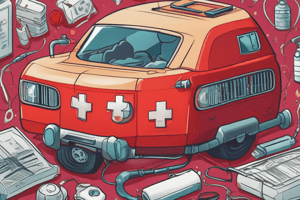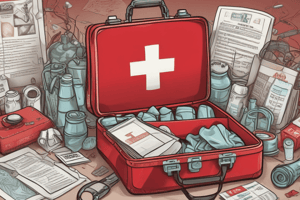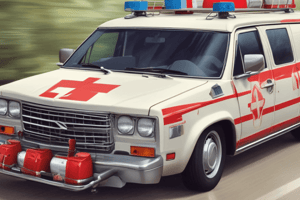Podcast
Questions and Answers
What is the first step to take before approaching an injured or ill person?
What is the first step to take before approaching an injured or ill person?
- Obtain the person's consent before providing first aid
- Check the scene for safety and look for any hazards (correct)
- Form an initial impression by shouting and tapping their shoulder
- Use personal protective equipment to reduce the risk of disease transmission
What type of consent is acceptable when the person is unconscious?
What type of consent is acceptable when the person is unconscious?
- Verbal consent
- Informed consent
- Implied consent (correct)
- Express consent
What is the purpose of the 'shout-tap-shout' method in first aid?
What is the purpose of the 'shout-tap-shout' method in first aid?
- To check for responsiveness and determine the severity of the injury (correct)
- To provide rescue breathing and chest compressions
- To obtain the person's consent before providing first aid
- To assess the scene for safety and look for hazards
Why is it essential to use personal protective equipment (PPE) in first aid?
Why is it essential to use personal protective equipment (PPE) in first aid?
What should you do if the person is unresponsive after using the 'shout-tap-shout' method?
What should you do if the person is unresponsive after using the 'shout-tap-shout' method?
What is the main purpose of first aid?
What is the main purpose of first aid?
Flashcards are hidden until you start studying
Study Notes
First Aid: Before Giving Care and Checking an Injured or Ill Person
First aid is a crucial skill that everyone should know. It's a set of procedures designed to provide emergency assistance to someone who is injured or ill. Before providing care, it is essential to ensure your safety and assess the situation. Here's a step-by-step guide on what to do before giving care and checking an injured or ill person:
Check the Scene for Safety
Before approaching the person, ensure the scene is safe. Look for any hazards that could put you or the person at risk, such as live wires, gas leaks, or unstable structures. Once you've determined the scene is safe, proceed with caution.
Form an Initial Impression
Approach the person calmly and ask if they need help. If they are unresponsive or in distress, use the 'shout-tap-shout' method to check for responsiveness:
- Shout their name and ask if they are okay.
- Tap their shoulder and ask if they are okay.
- If there is no response, shout again and perform rescue breathing and chest compressions, if necessary.
Obtain Consent and Use PPE
Always obtain the person's consent before providing first aid. If they are unconscious, you may not be able to get their explicit consent. In such cases, implied consent is acceptable. Additionally, use personal protective equipment (PPE) like gloves to reduce the risk of disease transmission.
Check for Life-Threatening Conditions
If the person is unresponsive or not breathing, call for emergency assistance immediately. If they are responsive, ask about signs and symptoms, allergies, and medical conditions (SAM). Perform a focused physical examination based on their response and the information you have gathered.
Call for Help and Provide Care
Once you have assessed the situation, call for emergency assistance if necessary. Then, provide care based on the condition found and your level of training. Continue checking the person to determine if additional care is needed.
Remember, the key to providing effective first aid is to act quickly and confidently. Knowing these steps can help you respond effectively in an emergency situation.
Studying That Suits You
Use AI to generate personalized quizzes and flashcards to suit your learning preferences.




